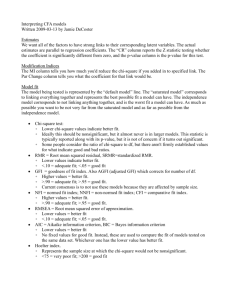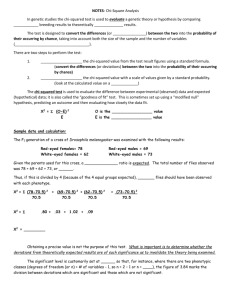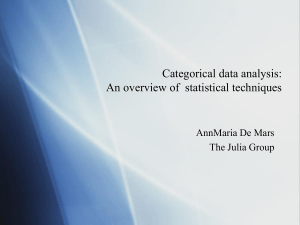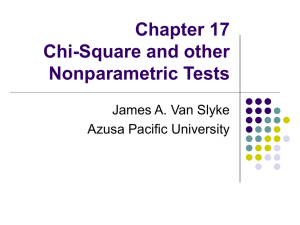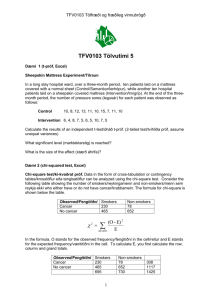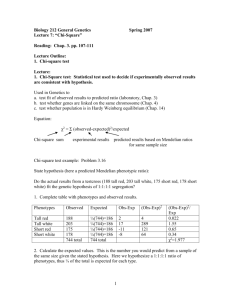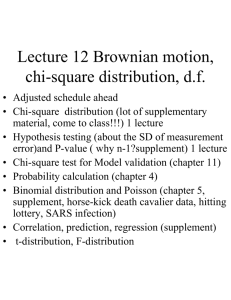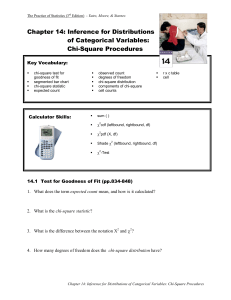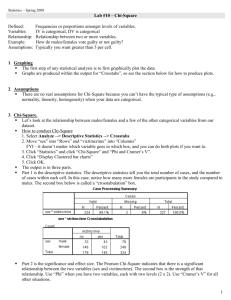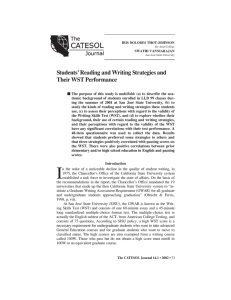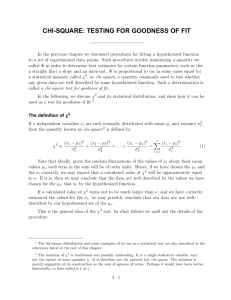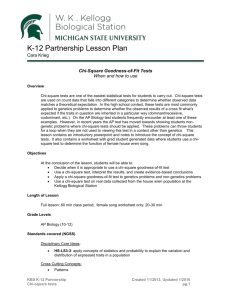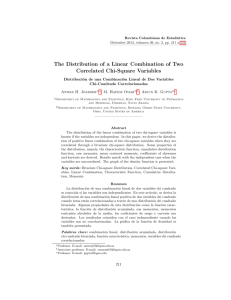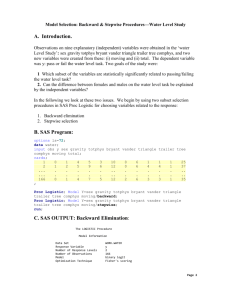HANDOUT: Chi-Square Background Sheet
advertisement
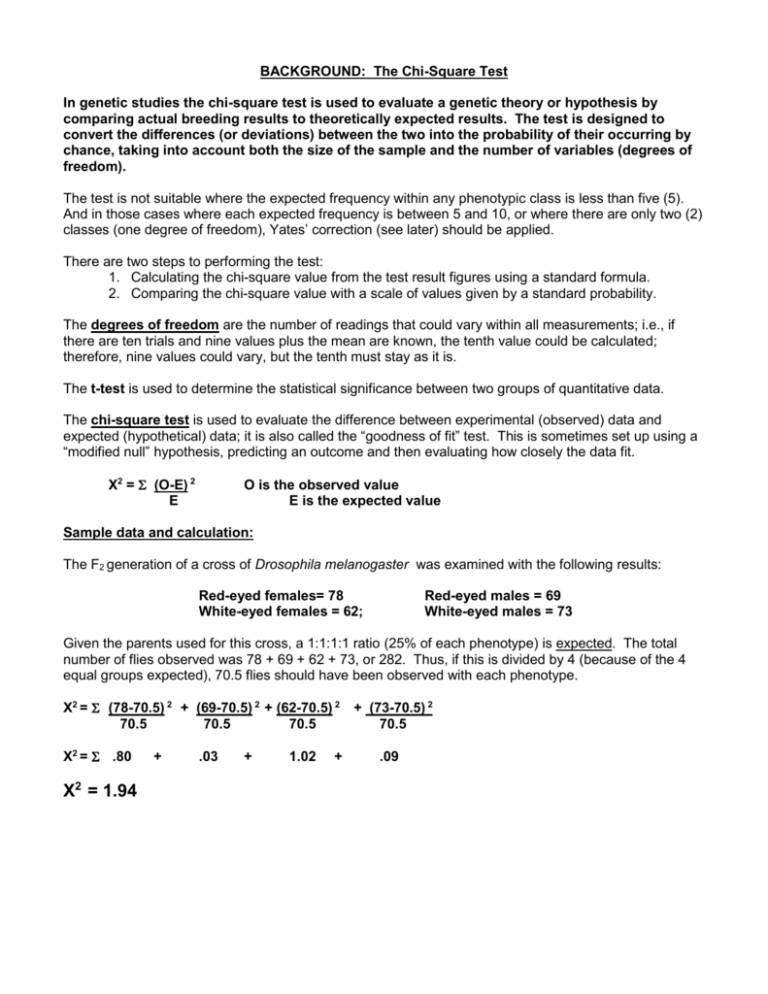
BACKGROUND: The Chi-Square Test In genetic studies the chi-square test is used to evaluate a genetic theory or hypothesis by comparing actual breeding results to theoretically expected results. The test is designed to convert the differences (or deviations) between the two into the probability of their occurring by chance, taking into account both the size of the sample and the number of variables (degrees of freedom). The test is not suitable where the expected frequency within any phenotypic class is less than five (5). And in those cases where each expected frequency is between 5 and 10, or where there are only two (2) classes (one degree of freedom), Yates’ correction (see later) should be applied. There are two steps to performing the test: 1. Calculating the chi-square value from the test result figures using a standard formula. 2. Comparing the chi-square value with a scale of values given by a standard probability. The degrees of freedom are the number of readings that could vary within all measurements; i.e., if there are ten trials and nine values plus the mean are known, the tenth value could be calculated; therefore, nine values could vary, but the tenth must stay as it is. The t-test is used to determine the statistical significance between two groups of quantitative data. The chi-square test is used to evaluate the difference between experimental (observed) data and expected (hypothetical) data; it is also called the “goodness of fit” test. This is sometimes set up using a “modified null” hypothesis, predicting an outcome and then evaluating how closely the data fit. X2 = (O-E) 2 E O is the observed value E is the expected value Sample data and calculation: The F2 generation of a cross of Drosophila melanogaster was examined with the following results: Red-eyed females= 78 White-eyed females = 62; Red-eyed males = 69 White-eyed males = 73 Given the parents used for this cross, a 1:1:1:1 ratio (25% of each phenotype) is expected. The total number of flies observed was 78 + 69 + 62 + 73, or 282. Thus, if this is divided by 4 (because of the 4 equal groups expected), 70.5 flies should have been observed with each phenotype. X2 = (78-70.5) 2 + (69-70.5) 2 + (62-70.5) 2 70.5 70.5 70.5 X2 = .80 X2 = 1.94 + .03 + 1.02 + + (73-70.5) 2 70.5 .09 Students must next consult the Chi-Square table provided in the AP Biology laboratory manual to determine whether or not this is within an acceptable range to support the hypothesis that the results are due to the particular cross rather than a random change. n 1 2 3 4 5 6 7 8 9 10 15 20 25 30 P= .99 .000157 .0201 .115 .297 .554 .872 1.239 1.646 2.088 2.558 5.229 8.260 11.524 14.953 P =.95 .00393 .103 .352 .711 1.145 1.635 2.167 2.733 3.325 3.940 7.261 10.851 14.611 18.493 P = .80 .0642 .446 1.005 1.649 2.343 3.070 3.822 4.594 5.380 6.179 10.307 14.578 18.940 23.364 P = .50 .455 1.386 2.366 3.357 4.351 5.348 6.346 7.344 8.343 9.342 14.339 19.337 24.337 29.336 P = .20 1.642 3.219 4.642 5.989 7.289 8.558 9.803 11.030 12.242 13.442 19.311 25.038 30.675 36.250 P = .05 3.841 5.991 7.815 9.488 11.070 12.592 14.067 15.057 16.919 18.307 24.996 31.410 37.652 43.773 P = .01 6.635 9.210 11.345 13.277 15.086 16.812 18.475 20.090 21.666 23.209 30.578 37.566 44.314 50.892 An estimation of the probability value is obtained by looking along the line representing the number of phenotypic classes being considered and comparing the calculated chi-square value to those in the table (degrees of freedom = n = # of actual phenotypic classes – 1). The calculated value will lie between two values corresponding to percentages at the head of the table. Obtaining a precise value is not the purpose of this test. What is important is to determine whether the deviations from theoretically expected results are of such significance as to invalidate the theory being examined. The significant level is customarily set at 5% so that, for instance, where there are two phenotypic classes (degrees of freedom, n = 1), the figure of 3.84 marks the division between deviations which are significant and those which are not significant. **Using the sample data, for 4 phenotypic classes (n = 3), a chi-square value of 1.94 is obtained which lies between values indicating probabilities of 50% and 80%; let’s say 60%. This indicates that in a large number of similar tests deviations as great as, or greater than that observed, would occur in about 60% of those tests by chance alone. This is greater than the significant 5% level and we can conclude that this test does NOT invalidate theoretical expectations. Now you try!… Problem: Using Mendel’s methods in crossing pea plants, the following results were collected in a cross between two plants heterozygous for seed shape and seed color (RrYy X RrYy). (R = round, r = wrinkled; Y = yellow, y = green) RESULTS: 547 yellow-round; 193 green-round; 195 yellow-wrinkled; 65 green-wrinkled. a) What are the expected phenotype ratios in the offspring? b) In 1000 offspring, how many are expected of each phenotype? c) Perform a Chi-Square test with the results obtained. Do these results invalidate theoretical expectations?
